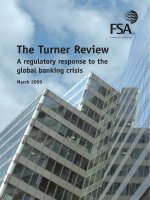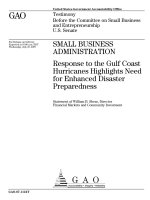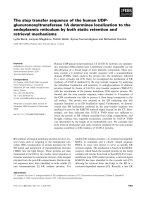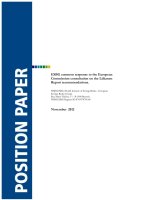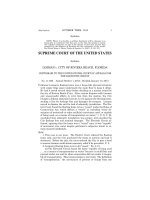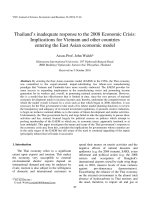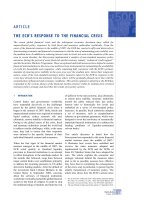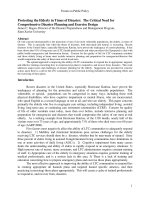Response to the Gulf Coast Hurricanes Highlights Need for Enhanced Disaster Preparedness docx
Bạn đang xem bản rút gọn của tài liệu. Xem và tải ngay bản đầy đủ của tài liệu tại đây (183.69 KB, 13 trang )
United States Government Accountabilit
y
Office
GAO
Testimony
Before the Committee on Small Business
and Entrepreneurship
U.S. Senate
SMALL BUSINESS
ADMINISTRATION
Response to the Gulf Coast
Hurricanes Highlights Need
for Enhanced Disaster
Preparedness
Statement of William B. Shear, Director
Financial Markets and Community Investment
For Release on Delivery
Expected at 10:00 a.m. EDT
Wednesday, July 25, 2007
GAO-07-1124T
What GAO Found
United States Government Accountability Office
Why GAO Did This Study
Highlights
Accountability Integrity Reliability
Jul
y
25, 2007
SMALL BUSINESS ADMINISTRATION
Response to the Gulf Coast Hurricanes
Highlights Need for Enhanced Disaster
Preparedness
Highlights of
GAO-07-1124T, a testimony
before the Committee on Small Business
and Entrepreneurship, U.S. Senate
The Small Business Administration
(SBA) helps individuals and
businesses recover from disasters
such as hurricanes through its
Disaster Loan Program. SBA faced
an unprecedented demand for
disaster loan assistance following
the 2005 Gulf Coast hurricanes
(Katrina, Rita, and Wilma), which
resulted in extensive property
damage and loss of life. In the
aftermath of these disasters,
concerns were expressed regarding
the timeliness of SBA's disaster
assistance.
GAO initiated work and completed
two reports under the Comptroller
General's authority to conduct
evaluations and determine how
well SBA provided victims of the
Gulf Coast hurricanes with timely
assistance. This testimony, which is
based on these two reports,
discusses (1) challenges SBA
experienced in providing victims of
the Gulf Coast hurricanes with
timely assistance, (2) factors that
contributed to these challenges,
and (3) steps SBA has taken since
the Gulf Coast hurricanes to
enhance its disaster preparedness.
GAO visited the Gulf Coast region,
reviewed SBA planning documents,
and interviewed SBA officials.
What GAO Recommends
GAO recommends that SBA take
several steps to improve its
disaster preparedness, and SBA
agreed with these
recommendations.
GAO identified several significant system and logistical challenges that SBA
experienced in responding to the Gulf Coast hurricanes that undermined the
agency’s ability to provide timely disaster assistance to victims. For
example, the limited capacity of SBA’s automated loan processing system—
the Disaster Credit Management System (DCMS)—restricted the number of
staff who could access the system at any one time to process disaster loan
applications. In addition, SBA staff who could access DCMS initially
encountered multiple system outages and slow response times in completing
loan processing tasks. SBA also faced challenges training and supervising
the thousands of mostly temporary employees the agency hired to process
loan applications and obtaining suitable office space for its expanded
workforce. As of late May 2006, SBA processed disaster loan applications, on
average, in about 74 days compared with its goal of within 21 days.
While the large volume of disaster loan applications that SBA received
clearly affected its capacity to provide timely disaster assistance to Gulf
Coast hurricane victims, GAO’s two reports found that the absence of a
comprehensive and sophisticated planning process beforehand likely limited
the efficiency of the agency's initial response. For example, in designing the
capacity of DCMS, SBA primarily relied on historical data such as the
number of loan applications that the agency received after the 1994
Northridge, California, earthquake—the most severe disaster that the agency
had previously encountered. SBA did not consider disaster scenari
os that
were more severe or use the information available from disaster simulations
(developed by federal agencies) or catastrophe models (used by insurance
companies to estimate disaster losses). SBA also did not adequately monitor
the performance of a DCMS contractor or completely stress test the system
prior to its implementation. Moreover, SBA did not engage in comprehensive
disaster planning prior to the Gulf Coast hurricanes for other logistical areas,
such as workforce planning or space acquisition, at either the headquarters
or field office levels.
While SBA has taken steps to enhance its capacity to respond to potential
disasters, the process is ongoing and continued commitment and actions by
agency managers are necessary. As of July 2006, SBA officials said that the
agency had completed an expansion of DCMS’s user capacity to support a
minimum of 8,000 concurrent users as compared with 1,500 concurrent
users supported for the Gulf Coast hurricanes. Further, in June 2007, SBA
released a disaster plan. While GAO has not evaluated the process SBA
followed in developing its plan, consistent with recommendations in GAO
reports, the plan states that SBA is incorporating catastrophe models into its
planning process, an effort which appears to be at an early stage. GAO
encourages SBA to actively pursue the use of catastrophe models and other
initiatives that may further enhance its capacity to better respond to future
disasters.
www.gao.gov/cgi-bin/getrpt?GAO-07-1124T.
To view the full product, including the scope
and methodology, click on the link above.
For more information, contact William B.
Shear at (202) 512-8678 or
Mr. Chairman and Members of the Committee:
I am pleased to be here today to discuss the Small Business
Administration’s (SBA) response to the 2005 Gulf Coast hurricanes
(Katrina, Rita, and Wilma), which caused more than 1,400 deaths and more
than $80 billion of estimated property damages. While SBA is generally
known for the financial support it provides to small businesses, the agency
also plays a critical, if less publicized role, in assisting the victims of
natural and other disasters. Specifically, SBA provides financial assistance
through its Disaster Loan Program to help homeowners, renters, and
businesses of all sizes recover from disasters such as earthquakes,
hurricanes, and terrorist attacks. Due to the damage associated with the
Gulf Coast hurricanes, SBA faced unprecedented demand for its disaster
loan services and, 9 months following the hurricanes, had approved nearly
150,000 such loans totaling nearly $10 billion. However, concerns have
been expressed that SBA’s response to the hurricanes was slow, leaving
many disaster victims without the timely assistance that they needed.
My statement today is based on two reports that we issued under the
Comptroller General’s authority to initiate reviews of federal programs.
The first report, which was released in July 2006, discussed SBA’s planning
for and implementation of the Disaster Credit Management System
(DCMS), which the agency uses to process disaster loan applications.
1
The
second report, which was released in February, discusses SBA’s disaster
planning for other logistical areas, such as hiring and training a capable
workforce and acquiring necessary office space.
2
I note that these reports
are part of a larger effort by GAO to assist Congress in assessing the
response of federal, state, and local agencies to the Gulf Coast hurricanes
and to identify steps that such organizations could take to improve the
provision of assistance and services to the victims of future disasters.
3
In my testimony, I will discuss (1) challenges SBA experienced in
providing victims of the Gulf Coast hurricanes with timely assistance, (2)
1
GAO, Small Business Administration: Actions Needed to Provide More Timely Disaster
Assistance
, GAO-06-860 (Washington, D.C.: July 28, 2006).
2
GAO, Small Business Administration: Additional Steps Needed to Enhance Agency
Preparedness for Future Disasters,
GAO-07-114 (Washington, D.C.: Feb. 14, 2007).
3
See, for example, GAO, Catastrophic Disasters: Enhanced Leadership, Capabilities, and
Accountability Controls Will Improve the Effectiveness of the Nation’s Preparedness,
Response, and Recovery System,
GAO-06-618 (Washington, D.C.: Sept. 6, 2006).
Page 1 GAO-07-1124T
factors that contributed to these challenges, and (3) steps SBA has taken
since the Gulf Coast hurricanes to enhance its disaster preparedness.
To address these objectives, we visited the Gulf Coast region, reviewed
documents related to SBA’s acquisition and implementation of DCMS,
reviewed reports that discuss disaster planning, analyzed relevant SBA
planning documentation, and interviewed disaster planning experts and
SBA officials in headquarters and field offices. We conducted the work on
our reports from November 2005 through January 2007 and in accordance
with generally accepted government auditing standards.
In summary:
• We identified several significant system and logistical challenges SBA
experienced in responding to victims of the Gulf Coast hurricanes that
compromised the agency’s ability to provide timely disaster assistance.
First, due to DCMS’s limited capacity, the number of staff who could
concurrently access the system to process disaster loans was restricted.
Further, SBA staff who were able to access DCMS often encountered
system outages and slow response times. Second, SBA faced challenges in
training and supervising thousands of mostly temporary employees hired
to process loan applications and encountered difficulties in obtaining
suitable office space for the expanded workforce. As a result of these and
other challenges, SBA averaged about 74 days to process disaster loan
applications, as of late May 2006, compared with the agency’s goal of
processing applications within 21 days.
• While the unprecedented volume of disaster loan applications clearly
affected SBA’s capacity to provide timely assistance to Gulf Coast
hurricane victims, the absence of a comprehensive and sophisticated
planning process beforehand likely limited the efficiency of the agency’s
initial response. For example, in designing the maximum user capacity of
DCMS, SBA primarily relied on historical data such as the number of loan
applications that it received after the 1994 Northridge, California,
earthquake—the most severe disaster that the agency had previously
encountered. SBA did not consider any disaster scenarios that were more
severe or use the information available from disaster simulations or
Page 2 GAO-07-1124T
catastrophe models to help design DCMS’s capacity.
4
SBA also did not
adequately monitor a DCMS contractor or completely stress test DCMS
prior to its implementation. Moreover, SBA did not engage in
comprehensive disaster planning for other logistical issues, such as
workforce or space acquisition planning, prior to the Gulf Coast
hurricanes at either the headquarters or field office levels.
• While SBA has taken steps to enhance its capacity to respond to potential
disasters, the process is ongoing and continued commitment and actions
by agency managers are necessary. As of July 2006, SBA officials said that
the agency had completed an expansion of DCMS’s user capacity to
support a minimum of 8,000 concurrent users as compared with 1,500
concurrent users supported for the Gulf Coast hurricanes. Further, in June
2007, SBA released a disaster plan. While we have not evaluated the
process SBA followed in developing its plan, consistent with
recommendations in our reports, the plan states that SBA is incorporating
catastrophe models into its planning process, an effort that appears to be
at an early stage. SBA’s plan also anticipates using 400 staff who are not
normally involved in disaster assistance programs to provide back-up
support in an emergency. SBA officials said about half of these individuals
will be trained as of the end of this month with the remainder trained by
this Fall. We encourage SBA to actively pursue this and other initiatives
that may further enhance its capacity to better respond to future disasters,
and we will monitor SBA’s efforts to implement our recommendations.
SBA was established by the Small Business Act of 1953 to fulfill the role of
several agencies that previously assisted small businesses affected by the
Great Depression and, later, by wartime competition. SBA’s stated purpose
is to promote small business development and entrepreneurship through
business financing, government contracting, and technical assistance
programs. In addition, SBA serves as a small business advocate, working
with other federal agencies to, among other things, reduce regulatory
burdens on small businesses.
Background
4
Federal agencies and other organizations have developed assessments of the potential
destructive consequences of varying disaster scenarios, which are intended to help federal,
state, and local agencies enhance their disaster planning. Moreover, many insurance
companies and state entities that provide catastrophe insurance coverage currently use
computer programs offered by several modeling firms to estimate the financial
consequences of various natural catastrophe scenarios.
Page 3 GAO-07-1124T
SBA also provides low-interest, long-term loans to individuals and
businesses to assist them with disaster recovery through its Disaster Loan
Program—the only form of SBA assistance not limited to small businesses.
Homeowners, renters, businesses of all sizes, and nonprofit organizations
can apply for physical disaster loans for permanent rebuilding and
replacement of uninsured or underinsured disaster-damaged property.
Small businesses can also apply for economic injury disaster loans to
obtain working capital funds until normal operations resume after a
disaster declaration. SBA’s Disaster Loan Program differs from the Federal
Emergency Management Agency’s (FEMA) Individuals and Households
Program (IHP). For example, a key element of SBA’s Disaster Loan
Program is that the disaster victim must have repayment ability before a
loan can be approved whereas FEMA makes grants under the IHP that do
not have to be repaid.
5
Further, FEMA grants are generally for minimal
repairs and, unlike SBA disaster loans, are not designed to help restore the
home to its predisaster condition.
In January 2005, SBA began using DCMS to process all new disaster loan
applications. SBA intended for DCMS to help it move toward a paperless
processing environment by automating many of the functions staff
members had performed manually under its previous system. These
functions include both obtaining referral data from FEMA and credit
bureau reports, as well as completing and submitting loss verification
reports from remote locations.
Our July 2006 report identified several significant limitations in DCMS’s
capacity and other system and procurement deficiencies that likely
contributed to the challenges that SBA faced in providing timely
assistance to Gulf Coast hurricane victims as follows:
• First, due to limited capacity, the number of SBA staff who could access
DCMS at any one time to process disaster loans was restricted. Without
access to DCMS, the ability of SBA staff to process disaster loan
applications in an expeditious manner was diminished.
• Second, SBA experienced instability with DCMS during the initial months
following Hurricane Katrina, as users encountered multiple outages and
slow response times in completing loan processing tasks. According to
DCMS’s Limited
Capacity and
Difficulties in Other
Logistical Areas
Impeded SBA’s
Response to the Gulf
Coast Hurricanes
5
FEMA grants are also not available to businesses.
Page 4 GAO-07-1124T
SBA officials, the longest period of time DCMS was unavailable to users
due to an unscheduled outage was 1 business day. These unscheduled
outages and other system-related issues slowed productivity and affected
SBA’s ability to provide timely disaster assistance.
• Third, ineffective technical support and contractor oversight contributed
to the DCMS instability that SBA staff initially encountered in using the
system. Specifically, a DCMS contractor did not monitor the system as
required or notify the agency of incidents that could increase system
instability. Further, the contractor delivered computer hardware for DCMS
to SBA that did not meet contract specifications.
In the report released in February, we identified other logistical challenges
that SBA experienced in providing disaster assistance to Gulf Coast
hurricane victims. For example, SBA moved urgently to hire more than
2,000 mostly temporary employees at its Ft. Worth, Texas disaster loan
processing center through newspaper and other advertisements (the
facility increased from about 325 staff in August 2005 to 2,500 in January
2006). SBA officials said that ensuring the appropriate training and
supervision of this large influx of inexperienced staff proved very difficult.
Prior to Hurricane Katrina, SBA had not maintained the status of its
disaster reserve corps, which was a group of potential voluntary
employees trained in the agency’s disaster programs. According to SBA,
the reserve corps, which had been instrumental in allowing the agency to
provide timely disaster assistance to victims of the September 11, 2001
terrorist attacks, shrank from about 600 in 2001 to less than 100 in August
2005.
6
Moreover, SBA faced challenges in obtaining suitable office space to
house its expanded workforce. For example, SBA’s facility in Ft. Worth
only had the capacity to house about 500 staff whereas the agency hired
more than 2,000 mostly temporary staff to process disaster loan
applications. While SBA was able to identify another facility in Ft. Worth
to house the remaining staff, it had not been configured to serve as a loan
processing center. SBA had to upgrade the facility to meet its
requirements. Fortunately, in 2005, SBA was also able to quickly
6
SBA’s disaster reserve corps consists of individuals, including retirees and students, who
have backgrounds in the agency’s disaster assistance programs (e.g., finance and customer
support) and who are willing to work on a temporary basis for the agency in an emergency
situation. Such individuals must agree to relocate within 40 hours of notification of a
disaster situation where their services are required by SBA.
Page 5 GAO-07-1124T
reestablish a loan processing facility in Sacramento, California, that had
been previously slated for closure under an agency reorganization plan.
The facility in Sacramento was available because its lease had not yet
expired, and its staff was responsible for processing a significant number
of Gulf Coast hurricane related disaster loan applications.
As a result of these and other challenges, SBA developed a large backlog
of applications during the initial months following Hurricane Katrina. This
backlog peaked at more than 204,000 applications 4 months after
Hurricane Katrina. By late May 2006, SBA took about 74 days on average
to process disaster loan applications, compared with the agency’s goal of
within 21 days.
As we stated in our July 2006 report, the sheer volume of disaster loan
applications that SBA received was clearly a major factor contributing to
the agency’s challenges in providing timely assistance to Gulf Coast
hurricane. As of late May 2006, SBA had issued 2.1 million loan
applications to hurricane victims, which was four times the number of
applications issued to victims of the 1994 Northridge, California,
earthquake, the previous single largest disaster that the agency had faced.
Within 3 months of Hurricane Katrina making landfall, SBA had received
280,000 disaster loan applications or about 30,000 more applications than
the agency received over a period of about 1 year after the Northridge
earthquake.
However, our two reports on SBA’s response to the Gulf Coast hurricanes
also found that the absence of a comprehensive and sophisticated
planning process contributed to the challenges that the agency faced.
7
For
example, in designing DCMS, SBA used the volume of applications
received during the Northridge, California, earthquake and other historical
data as the basis for planning the maximum number of concurrent agency
users that the system could accommodate. SBA did not consider the
likelihood of more severe disaster scenarios and, in contrast to insurance
companies and some government agencies, use the information available
from catastrophe models or disaster simulations to enhance its planning
process. Since the number of disaster loan applications associated with
Unprecedented Loan
Application Volume
and SBA’s Limited
Disaster Planning
Contributed to
Challenges in
Providing Timely
Assistance to
Hurricane Victims
7
The report we issued in February (GAO-07-114) discusses the need for federal agencies
and other organizations to engage in comprehensive disaster planning based on previous
GAO work, reports by other investigative organizations, and the views of disaster planning
experts.
Page 6 GAO-07-1124T
the Gulf Coast hurricanes greatly exceeded that of the Northridge
earthquake, DCMS’s user capacity was not sufficient to process the surge
in disaster loan applications in a timely manner.
Additionally, SBA did not adequately monitor the performance of a DCMS
contractor or stress test the system prior to its implementation. In
particular, SBA did not verify that the contractor provided the agency with
the correct computer hardware specified in its contract. SBA also did not
completely stress test DCMS prior to implementation to ensure that the
system could operate effectively at maximum capacity. If SBA had verified
the equipment as required or conducted complete stress testing of DCMS
prior to implementation, its capacity to process Gulf Coast related disaster
loan applications may have been enhanced.
In the report we issued in February, we found that SBA did not engage in
comprehensive disaster planning for other logistical areas—such as
workforce or space acquisition planning—prior to the Gulf Coast
hurricanes at either the headquarters or field office levels. For example,
SBA had not taken steps to help ensure the availability of additional
trained and experienced staff such as (1) cross-training agency staff not
normally involved in disaster assistance to provide backup support or (2)
maintaining the status of the disaster reserve corps as I previously
discussed. In addition, SBA had not thoroughly planned for the office
space requirements that would be necessary in a disaster the size of the
Gulf Coast hurricanes. While SBA had developed some estimates of
staffing and other logistical requirements, it largely relied on the expertise
of agency staff and previous disaster experiences—none of which reached
the magnitude of the Gulf Coast hurricanes—and, as was the case with
DCMS planning, did not leverage other planning resources, including
information available from disaster simulations or catastrophe models.
In our July 2006 report, we recommended that SBA take several steps to
enhance DCMS, such as reassessing the system’s capacity in light of the
Gulf Coast hurricane experience and reviewing information from disaster
simulations and catastrophe models. We also recommended that SBA
strengthen its DCMS contractor oversight and further stress test the
system. SBA agreed with these recommendations. I note that SBA has
completed an effort to expand DCMS’s capacity. SBA officials said that
DCMS can now support a minimum of 8,000 concurrent agency users as
compared with only 1,500 concurrent users for the Gulf Coast hurricanes.
Additionally, SBA has awarded a new contract for the project management
and information technology support for DCMS. The contractor is
SBA Has Taken Steps
to Better Prepare for
Disasters, but
Continued
Commitment and
Actions Are
Necessary
Page 7 GAO-07-1124T
responsible for a variety of DCMS tasks on SBA’s behalf including
technical support, software changes and hardware upgrades, and
supporting all information technology operations associated with the
system.
In the report released in February, we identified other measures that SBA
had planned or implemented to better prepare for and respond to future
disasters. These steps include appointing a single individual to coordinate
the agency’s disaster preparedness planning and coordination efforts,
enhancing systems to forecast the resource requirements to respond to
disasters of varying scenarios, redesigning the process for reviewing
applications and disbursing loan proceeds, and enhancing its long-term
capacity to acquire adequate facilities in an emergency.
8
Additionally, SBA
had planned or initiated steps to help ensure the availability of additional
trained and experienced staff in the event of a future disaster. According
to SBA officials, these steps include cross-training staff not normally
involved in disaster assistance to provide back up support, reaching
agreements with private lenders to help process a surge in disaster loan
applications, and reestablishing the Disaster Active Reserve Corps, which
had reached about 630 individuals as of June 2007.
While SBA has taken a variety of steps to enhance its capacity to respond
to disasters, I note that these efforts are ongoing and continued
commitment and actions by agency managers are necessary. In June 2007,
SBA released a plan for responding to disasters. While we have not
evaluated the process SBA followed in developing its plan, according to
the SBA plan, the agency is incorporating catastrophe models into its
disaster planning processes as we recommended in both reports. For
example, the plan states that SBA is using FEMA’s catastrophe model,
which is referred to as HAZUS, in its disaster planning activities. Further,
based on information provided by SBA, the agency is also exploring the
use of models developed by private companies to assist in its disaster
planning efforts.
9
These efforts to incorporate catastrophe models into the
disaster planning process appear to be at an early stage.
8
As described in the report we issued in February (GAO-07-114), SBA faced a significant
backlog in disbursing the funds associated with approved disaster loans in July 2006. SBA
has redesigned the loan review and disbursement process in such a way that agency
officials believe disbursement performance has been improved significantly.
9
U.S. Small Business Administration letter to the Honorable Henry Waxman, dated Jun. 1,
2007.
Page 8 GAO-07-1124T
SBA’s plan also anticipates further steps to ensure an adequate workforce
is available to respond to a disaster, including training and using 400 non-
disaster program office staff to assist in responding to the 2007 hurricane
season and beyond. According to SBA officials, about 200 of these staff
members will be trained in reviewing loan applications and providing
customer service by the end of this month and the remainder will be
trained by this Fall. We encourage SBA to actively pursue initiatives that
may further enhance its capacity to better respond to future disasters, and
we will monitor SBA’s efforts to implement our recommendations.
Mr. Chairman, this concludes my prepared statement. I would be happy to
answer any questions at this time.
For further information on this testimony, please contact William B. Shear
at (202) 512- 8678 or Contact points for our Offices of
Congressional Affairs and Public Affairs may be found on the last page of
this statement. Individuals making key contributions to this testimony
included Wesley Phillips, Assistant Director; Triana Bash; Alison Gerry;
Marshall Hamlett; Barbara S. Oliver; and Cheri Truett.
Page 9 GAO-07-1124T
GAO Contact and
Staff
Acknowledgments
(250360)
This is a work of the U.S. government and is not subject to copyright protection in the
United States. It may be reproduced and distributed in its entirety without further
permission from GAO. However, because this work may contain copyrighted images or
other material, permission from the copyright holder may be necessary if you wish to
reproduce this material separately.
GAO’s Mission
The Government Accountability Office, the audit, evaluation and
investigative arm of Congress, exists to support Congress in meeting its
constitutional responsibilities and to help improve the performance and
accountability of the federal government for the American people. GAO
examines the use of public funds; evaluates federal programs and policies;
and provides analyses, recommendations, and other assistance to help
Congress make informed oversight, policy, and funding decisions. GAO’s
commitment to good government is reflected in its core values of
accountability, integrity, and reliability.
The fastest and easiest way to obtain copies of GAO documents at no cost
is through GAO’s Web site (
www.gao.gov). Each weekday, GAO posts
newly released reports, testimony, and correspondence on its Web site. To
have GAO e-mail you a list of newly posted products every afternoon, go
to
www.gao.gov and select “Subscribe to Updates.”
The first copy of each printed report is free. Additional copies are $2 each.
A check or money order should be made out to the Superintendent of
Documents. GAO also accepts VISA and Mastercard. Orders for 100 or
more copies mailed to a single address are discounted 25 percent. Orders
should be sent to:
U.S. Government Accountability Office
441 G Street NW, Room LM
Washington, D.C. 20548
To order by Phone: Voice: (202) 512-6000
TDD: (202) 512-2537
Fax: (202) 512-6061
Contact:
Web site:
www.gao.gov/fraudnet/fraudnet.htm
E-mail:
Automated answering system: (800) 424-5454 or (202) 512-7470
Gloria Jarmon, Managing Director,
(202) 512-4400
U.S. Government Accountability Office, 441 G Street NW, Room 7125
Washington, D.C. 20548
Paul Anderson, Managing Director,
(202) 512-4800
U.S. Government Accountability Office, 441 G Street NW, Room 7149
Washington, D.C. 20548
Obtaining Copies of
GAO Reports and
Testimony
Order by Mail or Phone
To Report Fraud,
Waste, and Abuse in
Federal Programs
Congressional
Relations
Public Affairs
PRINTED ON
RECYCLED PAPER

